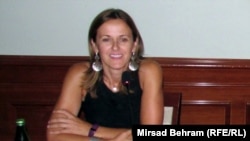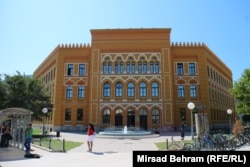Mostar is flooded with tourists at the moment. Ignoring temperatures of over 40 degrees Celsius, people from all over the word have been flocking to the Bosnian city in record numbers to see the Old Bridge, a masterpiece of 16th-century Ottoman architecture.
There is nothing to indicate to the visitors whether they are on the Muslim or the Croat bank of the Neretva River. That imaginary dividing line only exists in the hearts and minds of the people of Mostar. It corresponds to the front line that ran through the center of the city and next to its main high school during the war of 1992-95.
In the immediate aftermath of the conflict, the high school was given a Croat name and was reserved exclusively for ethnic Croat youth. Under pressure from the international community, in 2003 the Croat and Muslim high schools were formally integrated. However, that move only led to a form of apartheid that is becoming common throughout Bosnia-Herzegovina. It's a system of two schools under one roof. On the surface everything appears normal, with Croat and Muslim kids attending classes in the same building. In reality, they follow different curricula, have different teachers, classrooms, and school officials.
The Narcissism Of Minor Differences
At least the school building itself has been renovated. The beautiful neo-Moorish structure built in 1902 has been restored and repainted in its original vivid colors.
According to Syracuse University professor Azra Hromadzic, the newly "unified" high school does not simply reflect the ethnic divisions in Bosnian society, but rather reproduces them. She was in Mostar to attend the launch of the Bosnian translation of her new book, Citizens Of An Empty Nation, which is focused on the main high school as a symbol of a divided city.
"Divisions are unavoidable -- we have a problem only when divisions are overdetermined by a particular form of identity," says Hromadzic, who teaches anthropology at Syracuse. In her book she analyzes how the narcissism of minor differences has become the dominant feature of post-war Bosnian society, in which ethnicity annihilates all other identities -- and in the process denies Bosnian history and tradition.
Toilets As Common Ground
Life in post-Dayton Bosnia is determined by the constitutional idea of two nations living side by side but never coming into contact with one another.
It is a model that goes against the grain of Bosnia's history of ethnic pluralism.
"Divisions did not cause the war -- they are the result of war. But the reason why divisions remain in society is related to the way how differences are being managed," says Hromadzic. Pointing out that there is no shared public space where people of different ethnic groups can come together, Hromadzic goes back to her case study, the Mostar high school.
"The only place where students of different ethnicities come across each other is the school toilet."
"That is the place where they come for a secret cigarette. I just discovered that by accident while I was doing my research at the school. There were no professional guidelines on how to conduct an ethnographic study in a toilet."
Not only in the Mostar high school, but in Bosnia as a whole, public space has been reduced to ethnic space.
After school each student goes to her or his bank of the Neretva River -- a daily reality replicated throughout the country.
"Interaction between people of different ethnicities has been banished to the smelly toilets," Hromadzic told an international forum in Mostar on August 2.
'Afraid To Cross The Bridge'
The school is educating young people who do not identify with the Bosnian state -- only with their ethnic group.
"I was a student in the Mostar high school that is part of that unfortunate project -- two schools under one roof," says Lana Prlic, now the vice president of Bosnia's Social-Democratic Party.
"Bosniak kids in one class," she says, referring to Bosnian Muslims. "Croat kids in another."
"While we separate our children," she notes, the top floor of the school houses the United World College Mostar, where around 150 young people from across the world gather to learn about differences.
Two years ago, a student from the Mostar high school appeared on "Perspektiva," a program produced by RFE/RL and NED (National Endowment for Democracy), and made waves in the region by stating that he had never crossed Mostar's famous Old Bridge. The boundaries of his world are the boundaries of the Croat part of the city.
"The whole world knows Mostar for its Old Bridge, and I -- a Mostar native -- had never set foot on it, because I'm afraid," the young man explained at the time, adding that he dreamed about studying at the Faculty of Traffic and Communications in Sarajevo, but that he was apprehensive about being in an environment where ethnic Bosniaks were in the majority.
Known to the public only by his first name, Ante, he expressed anxiety over what might happen to him on the other side of the river, where "the others" live. In one of the later episodes of this youth-oriented show, Ante was filmed by a TV crew as he finally crossed the river and had a coffee on the other side.
'Sniffing Warily From Behind The Bushes'
Another student, reflecting on Ante's experience, made the following comments on the "Bljesak" portal:
It would be hypocritical of me to say that when I first came into contact with those from 'the other side' -- when I was 15 -- I did not have any prejudices. We were among the first classes to have the courage to attend that school. That's what it took -- courage. A decade or so ago, the old high school had a terrible reputation. It was still bullet-ridden and full of shrapnel holes, and stood on the dividing line, seen as the place of constant clashes and disturbances. It was attended by both Bosniaks and Croats. Classes were small, because few wanted to go to such a school.
We observed each other from a distance, sniffed warily from behind the bushes, and then we slowly approached one another and saw that we were the same. There were no fights or riots. Only some minor provocations when the football matches were on, mainly in the form of some graffiti in the toilets. Ironically, it was precisely in the toilets where we came together and interacted.
Yet another reminder of Bosnian fractured society. It appears that, as long as ethnicity is the only way of expressing identity, rebuilding a 16th-century bridge was easy compared to the task of rebuilding broken relations between ethnic groups.








